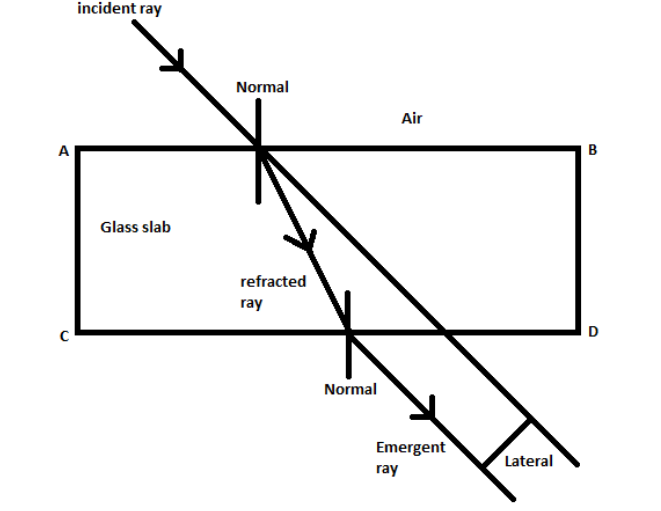
What causes the refraction of light ?
Answer
434.4k+ views
Hint: In order to answer the above question, we will be studying the phenomenon of refraction of light. We will study about the cause of refraction. We will also be studying the factors which play a vital role in refraction and the amount of bending of light.
Complete answer:
The bending of light (as well as sound, water, and other waves) as it moves through one transparent material into another is known as refraction. Lenses, magnifying glasses, prisms, and rainbows are all possible because of this bending by refraction. Even our eyes are reliant on light bending. We wouldn't be able to concentrate light through our retina without refraction.
As we all know, when light passes at an angle through a material with a particular refractive index, it refracts (optical density). A change in speed causes this change in direction. As light travels from air to water, for example, it slows down and continues to travel at an angle or in a different direction.
The amount of bending is determined by two factors:
Change in speed: a material that allows light to refract (bend) more can cause it to speed up or slow down more.
Angle of the incident ray: the amount of refraction would be more significant if the light enters the material at a greater angle. On the other side, if light enters the new material from the front (at

All angles are calculated using a
-As light passes through a material with a higher refractive index than air (such as glass), it slows down. The light bends in the direction of the normal line.
-As light reaches a material with a lower refractive index (for example, from glass to air), it accelerates. The light deviates from the normal line.
-When light reaches a material with a higher refractive index, it can slow down and change direction more.
It can be concluded from the above answer that the main cause of refraction is the change in the speed of light due to the changing density of the material.
Note:It is very important to note that the refraction of light plays a very vital role in almost all the optical instruments as the main key part of any optical instrument is the lens. The phenomena of dispersion, i.e., the splitting of white light into seven colours, which causes the rainbow is caused due to the refraction of light.
Complete answer:
The bending of light (as well as sound, water, and other waves) as it moves through one transparent material into another is known as refraction. Lenses, magnifying glasses, prisms, and rainbows are all possible because of this bending by refraction. Even our eyes are reliant on light bending. We wouldn't be able to concentrate light through our retina without refraction.
As we all know, when light passes at an angle through a material with a particular refractive index, it refracts (optical density). A change in speed causes this change in direction. As light travels from air to water, for example, it slows down and continues to travel at an angle or in a different direction.
The amount of bending is determined by two factors:
Change in speed: a material that allows light to refract (bend) more can cause it to speed up or slow down more.
Angle of the incident ray: the amount of refraction would be more significant if the light enters the material at a greater angle. On the other side, if light enters the new material from the front (at

All angles are calculated using a
-As light passes through a material with a higher refractive index than air (such as glass), it slows down. The light bends in the direction of the normal line.
-As light reaches a material with a lower refractive index (for example, from glass to air), it accelerates. The light deviates from the normal line.
-When light reaches a material with a higher refractive index, it can slow down and change direction more.
It can be concluded from the above answer that the main cause of refraction is the change in the speed of light due to the changing density of the material.
Note:It is very important to note that the refraction of light plays a very vital role in almost all the optical instruments as the main key part of any optical instrument is the lens. The phenomena of dispersion, i.e., the splitting of white light into seven colours, which causes the rainbow is caused due to the refraction of light.
Recently Updated Pages
Master Class 10 General Knowledge: Engaging Questions & Answers for Success

Master Class 10 Computer Science: Engaging Questions & Answers for Success

Master Class 10 Science: Engaging Questions & Answers for Success

Master Class 10 Social Science: Engaging Questions & Answers for Success

Master Class 10 Maths: Engaging Questions & Answers for Success

Master Class 10 English: Engaging Questions & Answers for Success

Trending doubts
A boat goes 24 km upstream and 28 km downstream in class 10 maths CBSE

Why is there a time difference of about 5 hours between class 10 social science CBSE

The British separated Burma Myanmar from India in 1935 class 10 social science CBSE

The Equation xxx + 2 is Satisfied when x is Equal to Class 10 Maths

Chandigarh is the capital of A Punjab B Haryana C Punjab class 10 social science CBSE

Change the following sentences into negative and interrogative class 10 english CBSE




